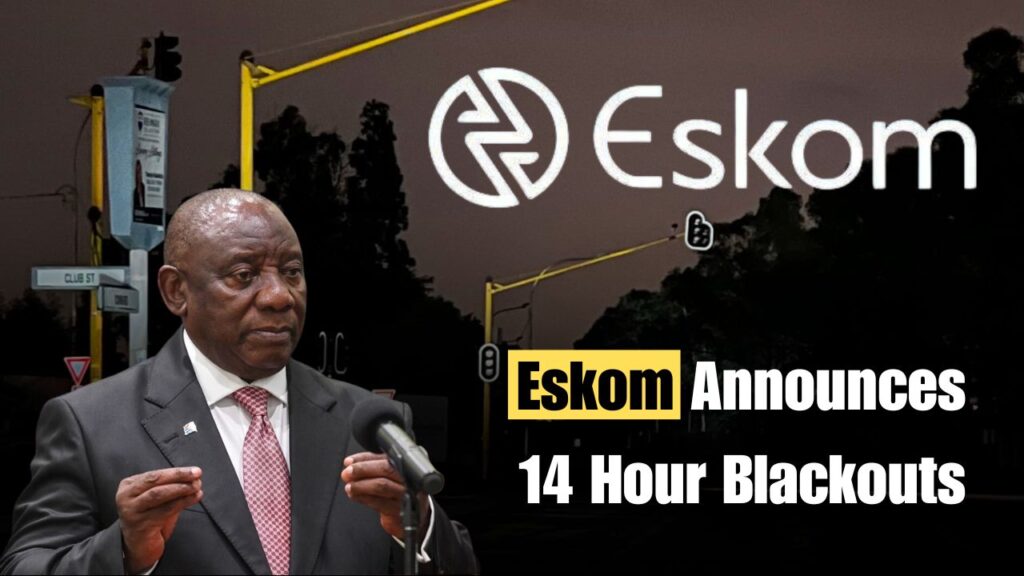South Africa is once again facing a nationwide power challenge as Eskom announces 14-hour load shedding across all provinces. The sudden return of scheduled blackouts has left households and businesses scrambling to plan their daily routines. This latest power outage schedule is part of Eskom’s effort to balance the grid and avoid a complete system collapse. With provinces like Gauteng, KwaZulu-Natal, and Western Cape heavily affected, citizens are urged to prepare for extended power cuts and conserve electricity wherever possible.

Reasons Behind the Latest Eskom Load Shedding
The Eskom load shedding for this month stems from a combination of critical maintenance, unplanned breakdowns, and reduced generating capacity. According to the utility, aging infrastructure and increasing demand have worsened the situation. Power stations in provinces like Mpumalanga and Limpopo are under heavy strain, resulting in stage 6 power cuts being implemented. Eskom has also cited challenges in obtaining sufficient diesel for peaking plants, which play a key role in stabilizing supply during evening peaks. The company is urging citizens to reduce their electricity usage and report any power faults immediately.
Read Also : New Electricity Billing Starts October 2025 Prepaid Meter Readiness Checklist & Avoid Power Cutoffs
Impact on Households and Businesses Across Provinces
Extended load shedding hours mean serious disruptions to both domestic and commercial life. Small businesses that rely on continuous electricity are experiencing revenue losses, while households struggle with food spoilage and internet downtime. In areas such as Johannesburg and Durban, many residents are turning to solar power alternatives and backup generators to stay functional during the long hours of darkness. Schools and healthcare facilities are also affected, prompting local authorities to arrange emergency backup supplies for essential services. The 14-hour cycle has led to frustration and growing demand for government intervention.
Eskom’s Updated Load Shedding Schedule for 2025
Eskom has released a detailed load shedding timetable to help South Africans plan their activities accordingly. The utility aims to rotate power cuts fairly across regions to minimize total impact. Residents can check the official EskomSePush app or Eskom’s website for updated timings. Urban centers such as Pretoria and Cape Town are expected to experience different stages at various hours. Authorities have emphasized that this rotational power schedule may change depending on generation performance and weather conditions that influence electricity consumption.
| Province | Load Shedding Duration | Stage Level | Expected Restoration |
|---|---|---|---|
| Gauteng | 14 Hours | Stage 6 | 1 November 2025 |
| KwaZulu-Natal | 13 Hours | Stage 5 | 27 November 2025 |
| Western Cape | 12 Hours | Stage 4 | 26 November 2025 |
| Eastern Cape | 11 Hours | Stage 3 | 26 November 2025 |
| Free State | 10 Hours | Stage 3 | 25 November 2025 |
How South Africans Can Prepare for the 14-Hour Blackout
Citizens are advised to prepare for long power interruptions by keeping devices fully charged, storing water, and ensuring alternative lighting sources like torches or candles are ready. Those working from home should back up important files and plan schedules around the load shedding timetable. It’s also smart to unplug electrical appliances to prevent damage from sudden surges when the power returns. Communities are coming together to share resources and ensure the safety of elderly and vulnerable residents during this nationwide blackout period.
FAQ 1: How long will the load shedding last?
Eskom expects the current 14-hour schedule to continue for several days until power generation improves.
FAQ 2: Which areas are most affected?
Gauteng, KwaZulu-Natal, and Western Cape are among the hardest hit provinces.
FAQ 3: How can I check my load shedding zone?
You can check your area’s schedule using the EskomSePush app or the official Eskom website.
FAQ 4: Is there government assistance during power cuts?
Local municipalities are coordinating emergency supplies and support for essential services and communities.



